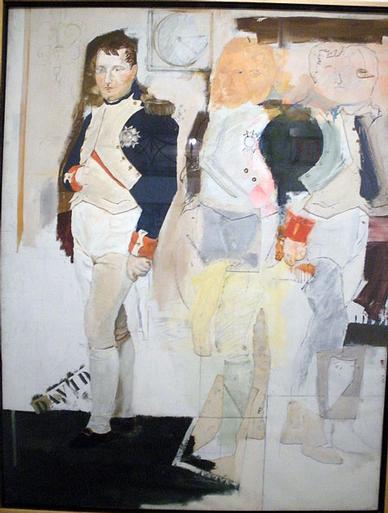
Even though Larry Rivers seemed, throughout his career, to be constantly at odds with whatever orthodoxy was dominant in the art world, the current exhibition of the late artist’s works at Guild Hall in East Hampton reveals an artist who seems instead to have been continually absorbing and reconfiguring accepted dogma rather than waging an unending battle against it.
Titled “Larry Rivers: Major Early Works” and featuring some of his most important paintings from the 1950s and 1960s, the exhibit underscores the measure of stylistic amalgamation that was a hallmark of his output as he strove to blur the boundaries between academically structured figuration, abstract expressionism, and his later use of pop art images.
Within this framework and as the work evolved, though, Mr. Rivers never sought to offer a relaxed blend of components, instead seeking a degree of tension in which different influences all came to the fore and seemed to exist in an uneasy alliance of line, color, surface texture, and imagery. The works on view at Guild Hall embody the painter Francis Bacon’s observation that “a picture should be a re-creation of an event rather than an illustration of an object; but there is no tension in the picture unless there is a struggle with the object.”
This type of struggle is particularly apparent in the large nude portraits included in the Guild Hall show, which profoundly accentuate the artist’s attempt in the early 1950s to highlight academically derived painterly inspiration while emphasizing in the figuration a severe and brusquely emotional sort of portraiture. His balancing of Philip Pearlstein’s later uncompromising dedication to picturing the human body absent any sense of idealization gains in impact from the expressively psychological aspects of his subjects, which Lucien Freud later described as “not having the look of the sitter, being them.”
While this psychological aspect is significant in portraits of the poet Frank O’Hara and the artist’s first wife, Augusta, it is even more notable in the celebrated works featuring his mother-in-law. Beginning with “Portrait of Berdie, Number II” (oil on canvas, 1953) which reflects the influence of de Kooning and the abstract expressionists, and continuing through a later series of drawings that reflects Mr. Rivers’s accomplished use of line, the series reaches an apogee in “Double Portrait of Berdie” (oil on canvas, 1955).
Seemingly juxtaposing a haphazard approach to anatomy and composition, the work conjures a strange and compelling narrative that is emphasized by the artist’s attentiveness to detail in much of the peripheral components in the work.
This contrast of painterly impulse and structural coherence is further accentuated by an entertainingly arresting use of perspective within the work, as if part of the image was painted from eye-level while other sections seem to imply the scene as if viewed from atop a step. The effect recalls Georges Braque’s statement that “perspective is a ghastly mistake which has taken four centuries to redress.”
This impulse to balance academic figuration and abstraction becomes more pronounced in the artist’s paintings from the 1960s and is especially apparent in “The Last Civil War Veteran” (oil on canvas, 1961). Exemplifying the artist’s developing interest in historical themes that reflect a frankly quixotic view of times past with a healthy nod to both nostalgia and idealism, the work draws attention to the artist’s developing use of both color and line as overlapping components in creating imagery and narrative.
The use of color and expressive painterly techniques emphasize a measure of spontaneity even as they firmly establish the planar dimensions within the work. This effect is further emphasized by the figuration, which, simply expressed in slashes of line, establishes an air of elegiac simplicity that is minimal in configuration yet powerful in emotional impact.
What is perhaps most surprising about this period of Mr. Rivers’s works is his developing departure from the orthodoxies of both pop art’s ironic detachment and the evolving intellectual distance of minimalism’s dogmatic view of abstraction, a departure that is profoundly evidenced in his monumental “History of the Russian Revolution” (mixed media construction, 1965).
Measuring 14 feet tall by 32 feet long and assembled as one huge, chronologically arranged jigsaw puzzle tracing the birth and evolution of the rise of Russian bolshevism in the early twentieth century, the work is majestic and dramatic: absent any latent sense of idealism yet nevertheless redolent of a dedication to historical romanticism.
“Larry Rivers: Major Early Works” continues at Guild Hall in East Hampton through October 19.